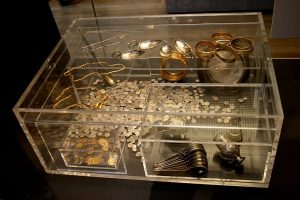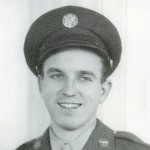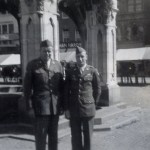suffolk
 I don’t know about you, but when I go looking for something I’ve lost, usually because I put it in a place that I would know where to find it, I always seem to find several other “treasures” I had forgotten I had. I can’t tell you how many times that has happened to me, even if I had been intently looking for the “treasure” that I finally find when I’m no longer looking for it. That happens to a lot of people, but it’s not likely that the “treasures” we find, are worth anywhere near the value of the treasure that was found by Eric Lawes, when on November 16, 1992, he set off for a field in Hoxne village, Suffolk. He wasn’t even heading out on a treasure hunt. He was searching for his lost hammer!!
I don’t know about you, but when I go looking for something I’ve lost, usually because I put it in a place that I would know where to find it, I always seem to find several other “treasures” I had forgotten I had. I can’t tell you how many times that has happened to me, even if I had been intently looking for the “treasure” that I finally find when I’m no longer looking for it. That happens to a lot of people, but it’s not likely that the “treasures” we find, are worth anywhere near the value of the treasure that was found by Eric Lawes, when on November 16, 1992, he set off for a field in Hoxne village, Suffolk. He wasn’t even heading out on a treasure hunt. He was searching for his lost hammer!!
At his recent retirement, Lawes had received a metal detector as a gift. So Lawes set off to find a hammer he had lost on the farmland. The detector picked up a strong signal in the earth, leading Lawes to start digging. Well…this was not his hammer. After bringing up only a few shovelfuls of silver spoons and gold coins, Lawes quickly retreated and called the police and the local archaeological society. The very next day, as quietly as possible, so as not to create a stir, the archaeologists excavated a chunk of earth with the treasure still contained within. They wanted to remove the objects under strict laboratory conditions, which would help determine the age and storage method of the cache. By the time everything had been removed from the dirt, the archaeologists had nearly 60 pounds of gold and silver objects, including 15,234 Roman coins, dozens of silver spoons, and 200 gold objects. The treasure, which later became labeled as the Hoxne Hoard, was an amazing discovery. Archaeologist Judith Plouviez was extremely excited about the discovery, saying that it was “an incredibly exciting and amazing find.” What’s more, another archaeologist, Rachel Wilkinson, told Smithsonian Magazine that this discovery was “the largest and latest ever found in Britain.”
Normal radiocarbon dating as a means of identifying the age of ancient relics didn’t work in this case. They just couldn’t locate any suitable material for radiocarbon dating from the haul. In the end, they determined the age  by examining writing on the coins, as well as the ruler carved into them. It was estimated that the treasure was probably buried in either 408 or 409 AD. How it had remained hidden all those years is beyond me…especially on a farm, where the field might have been plowed at any time. All in all, the discovery was a real treasure for archaeologists. Lawes didn’t lose out on the deal either. According to Smithsonian Magazine, in recognition of his discovery and willingness to contact authorities, the British government rewarded him with over £1.7 million (2,249,100 in US Dollars), an amount which he shared with the farmer whose land was dug out in order to get the treasure. Oh, and by the way, Lawes also found his lost hammer…which now also resides in the British Museum too.
by examining writing on the coins, as well as the ruler carved into them. It was estimated that the treasure was probably buried in either 408 or 409 AD. How it had remained hidden all those years is beyond me…especially on a farm, where the field might have been plowed at any time. All in all, the discovery was a real treasure for archaeologists. Lawes didn’t lose out on the deal either. According to Smithsonian Magazine, in recognition of his discovery and willingness to contact authorities, the British government rewarded him with over £1.7 million (2,249,100 in US Dollars), an amount which he shared with the farmer whose land was dug out in order to get the treasure. Oh, and by the way, Lawes also found his lost hammer…which now also resides in the British Museum too.

 Most of the time, when I think about the faces from my parents’ past, I think of ancestors, or school friends, or maybe even old flames. All of those people bring questions to mind, but most of them can be answered, and the relationship laid to rest, at least in the case of old friends or old flames, but some faces continue to run through my mind again and again. Such is the case with the men who served in the Army Air Force with my Dad at Great Ashfield Army Air Base, which is just North of Ipswich in Suffolk, England. I know these men were Dad’s good friends, because they were important enough to him to take their pictures to preserve their memory for the rest of his life, but for whatever reason, their names were not put on the pictures, so I don’t know who they were.
Most of the time, when I think about the faces from my parents’ past, I think of ancestors, or school friends, or maybe even old flames. All of those people bring questions to mind, but most of them can be answered, and the relationship laid to rest, at least in the case of old friends or old flames, but some faces continue to run through my mind again and again. Such is the case with the men who served in the Army Air Force with my Dad at Great Ashfield Army Air Base, which is just North of Ipswich in Suffolk, England. I know these men were Dad’s good friends, because they were important enough to him to take their pictures to preserve their memory for the rest of his life, but for whatever reason, their names were not put on the pictures, so I don’t know who they were.
Dad never talked much about the war, something that, while common among people who have fought in such battles, I nevertheless find strange. I always knew that he was a top turret gunner and flight engineer on a B-17 Bomber during World War II, but much of that information came from my mom. I guess she didn’t really know why Dad wouldn’t tell his daughters about something that made her and us so very proud of him either. I guess it just wasn’t his style, or maybe the memories of what he had to do there were just too hard to talk much about. Dad has always been such a gentleman, and had such a gentle spirit, that I’m quite certain that killing, even from a plane with a bomb, and not having to look at the faces of those who died, was something that was hard to live with, even though it was necessary, and even though he felt strongly about the purpose for which he was fighting.
In his letters home to his mom and family, he mentioned some names of friends from home, or people he trained with, but they were so restricted on what they could write about during their time in England, and the people they were with, that few names were mentioned. It was only after Dad had passed away, and we were going through pictures from his past for his slide show, that we found these pictures of his friends from his military days…those faces from Dad’s past, that I wonder about now. It was too late to ask Dad who they were then, and I have always been sorry about that. My niece, Michelle asked him about some of his military days for a report she was doing, but she didn’t know about these 
 pictures then, or she might have asked.
pictures then, or she might have asked.
I will probably never know who these men were, or if they were members of Dad’s crew on the B-17 he assigned to, and I am sorry about that. I have been trying to find out more about his military days and the men he served with, and these pictures could have been a great source of valuable information. Sadly, I will probably always wonder about the faces from Dad’s past, and the impact they had on his life.

